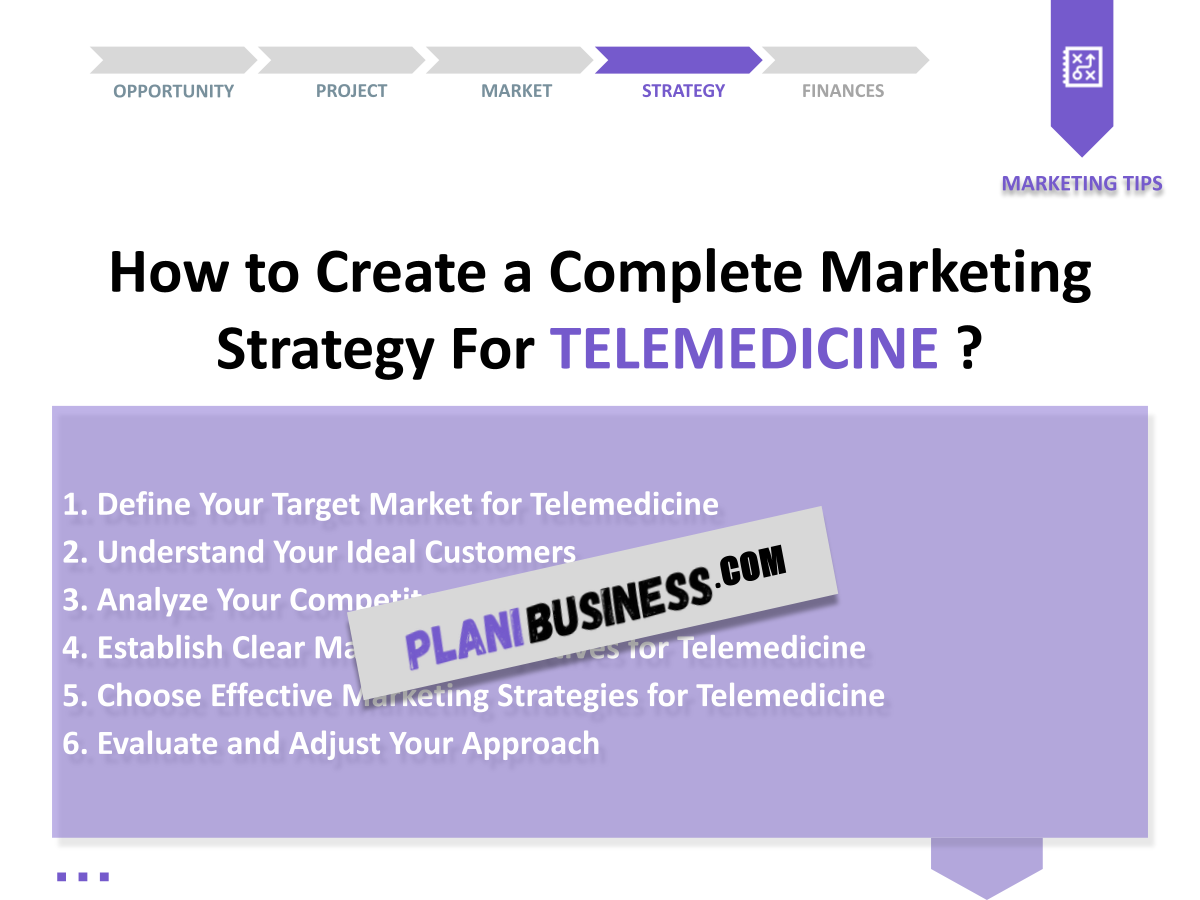Are you thinking about starting a telemedicine business? You’re not alone! The demand for remote healthcare services has skyrocketed, making it crucial for you to establish a solid Telemedicine Marketing Plan to stand out in the crowded market. In this article, we’ll dive into how you can create a comprehensive plan that will not only target the right audience but also help you analyze competitors and establish effective strategies.
1. Define Your Target Market for Telemedicine
| Criteria | Description |
|---|---|
| Demographics | Age, gender, income level |
| Geographics | Urban vs rural areas |
| Psychographics | Lifestyle, preferences |
Understanding who your target market is will help you tailor your marketing efforts effectively. You can segment your audience based on demographics, geographics, and psychographics to create targeted campaigns.
For instance, if you find that your primary audience is young adults in urban areas, you might focus on digital marketing strategies that appeal to their tech-savvy nature. Alternatively, if you discover that older adults in rural areas are in need of your services, you may want to consider traditional marketing methods alongside digital outreach to reach them effectively.
2. Understand Your Ideal Customers
| Characteristic | Details |
|---|---|
| Health Needs | What medical conditions are they facing? |
| Technology Use | Are they comfortable with digital tools? |
Knowing your ideal customers is vital. What are their health needs? How tech-savvy are they? These insights can help you refine your messaging and service offerings. For example, if your ideal customer base includes busy professionals who prefer quick access to healthcare services, you might emphasize convenience and speed in your marketing materials.
Additionally, understanding your customers’ comfort level with technology can guide you in choosing the right platforms for engagement. If they are not comfortable with digital tools, consider offering more personalized service options or easy-to-use interfaces.
3. Analyze Your Competitors
| Competitor | Strengths | Weaknesses |
|---|---|---|
| Competitor A | Strong brand recognition | Limited service options |
| Competitor B | Wide range of services | Poor customer service |
Look at what your competitors are doing. What are their strengths and weaknesses? Analyzing their strategies can give you an edge in crafting your own Telemedicine Marketing Plan. For example, if you notice that a competitor has strong brand recognition but limited service options, you could capitalize on this by offering a more diverse range of telemedicine services.
Furthermore, consider conducting a SWOT analysis (Strengths, Weaknesses, Opportunities, Threats) for each competitor. This can help you identify areas where you can differentiate your services and potentially attract their customers. Always keep an eye on customer reviews and feedback for insights on what patients appreciate or dislike about their offerings.
4. Establish Clear Marketing Objectives for Telemedicine
| Objective | Measurement |
|---|---|
| Increase brand awareness | Social media engagement |
| Grow patient base | New registrations |
Setting clear marketing objectives is crucial. What do you want to achieve? Whether it’s increasing brand awareness or growing your patient base, make sure you can measure your success. For instance, if your goal is to increase brand awareness, you could track metrics such as social media engagement, website traffic, and content shares.
Additionally, using SMART criteria (Specific, Measurable, Achievable, Relevant, Time-bound) can be beneficial in formulating your objectives. For example, instead of saying, “I want more patients,” a SMART objective would be, “I want to increase new patient registrations by 20% within the next six months.” This level of specificity helps you stay focused and evaluate your progress effectively.
5. Choose Effective Marketing Strategies for Telemedicine
| Strategy | Implementation |
|---|---|
| Content Marketing | Blog posts, videos |
| Social Media Advertising | Targeted ads |
What strategies will you use? From content marketing to social media advertising, choose approaches that resonate with your target market. Each strategy should align with your overall goals. For instance, content marketing can establish your authority in the field by providing valuable information to potential patients, while social media advertising can effectively target specific demographics.
Consider creating engaging blog posts about telehealth benefits, patient testimonials, or updates on healthcare trends. This not only helps in building trust but also boosts your search engine visibility. On the other hand, targeted ads on platforms like Facebook or Instagram can help you reach potential patients based on their interests and behaviors, maximizing your marketing budget.
6. Evaluate and Adjust Your Approach
| Evaluation Method | Details |
|---|---|
| Analytics Tools | Google Analytics, social media insights |
| Patient Feedback | Surveys, reviews |
Don’t forget to evaluate your efforts. Use analytics tools and gather patient feedback to see what’s working and what’s not. Adjust your strategies as needed to improve your Telemedicine Marketing Plan. For example, Google Analytics can provide insights into your website traffic, helping you understand which pages are performing well and which ones need improvement.
Additionally, consider sending out patient satisfaction surveys to gather direct feedback on their experiences. This can help you identify areas for improvement and demonstrate to your patients that you value their opinions. Remember, the healthcare landscape is always changing, so staying adaptable is key to your long-term success.
7. Example N°1 of Marketing Plan for Telemedicine
| Steps | Actions | Details |
|---|---|---|
| 1 | Target Market | Identify key demographics such as age and location. |
| 2 | Ideal Customers | Understand their health needs and technology usage. |
| 3 | Competitors | Analyze strengths and weaknesses of local telemedicine providers. |
| 4 | Marketing Objectives | Set measurable goals, like increasing new registrations by 20%. |
| 5 | Marketing Strategies | Utilize content marketing and social media ads. |
| 6 | Evaluation | Use analytics tools and patient feedback for adjustments. |
This example outlines a straightforward approach to developing a Telemedicine Marketing Plan. By focusing on each step methodically, you can create a solid foundation for your marketing efforts. It’s essential to continually refine your plan based on data and patient feedback to stay competitive in the evolving telehealth landscape.
8. Example N°2 of Marketing Plan for Telemedicine
| Steps | Actions | Details |
|---|---|---|
| 1 | Target Market | Segment by age group and health conditions. |
| 2 | Ideal Customers | Assess their preferences for online consultations. |
| 3 | Competitors | Review their online presence and service offerings. |
| 4 | Marketing Objectives | Aim for a 30% increase in patient engagement. |
| 5 | Marketing Strategies | Implement email marketing and webinars. |
| 6 | Evaluation | Track engagement metrics and adjust strategies. |
This second example illustrates a different approach, focusing on segmentation and patient engagement. By implementing various strategies such as email marketing and webinars, you can foster a deeper connection with your audience and encourage more patients to utilize your telemedicine services.
9. Example N°3 of Marketing Plan for Telemedicine
| Steps | Actions | Details |
|---|---|---|
| 1 | Target Market | Identify family demographics needing pediatric care. |
| 2 | Ideal Customers | Focus on parents with young children. |
| 3 | Competitors | Study local pediatric telemedicine options. |
| 4 | Marketing Objectives | Increase pediatric consultations by 25%. |
| 5 | Marketing Strategies | Host family-oriented health workshops online. |
| 6 | Evaluation | Analyze participation rates and follow-up surveys. |
This example emphasizes targeting families for pediatric telemedicine services. By hosting online health workshops that educate parents about common childhood illnesses and preventive care, you can build trust and encourage them to choose your services. The goal here is to create a community feel while increasing your patient base.
10. Example N°4 of Marketing Plan for Telemedicine
| Steps | Actions | Details |
|---|---|---|
| 1 | Target Market | Identify seniors needing regular healthcare access. |
| 2 | Ideal Customers | Focus on elderly patients with chronic conditions. |
| 3 | Competitors | Evaluate local services for seniors. |
| 4 | Marketing Objectives | Achieve a 40% increase in senior sign-ups. |
| 5 | Marketing Strategies | Partner with senior living communities for outreach. |
| 6 | Evaluation | Monitor engagement through community events. |
This example targets seniors, emphasizing the need for consistent healthcare access. By partnering with senior living communities, you can create tailored outreach programs that cater specifically to their healthcare needs. This approach not only increases sign-ups but also fosters a sense of community and support for elderly patients.
11. Example N°5 of Marketing Plan for Telemedicine
| Steps | Actions | Details |
|---|---|---|
| 1 | Target Market | Identify working professionals seeking flexible healthcare. |
| 2 | Ideal Customers | Focus on busy individuals who value convenience. |
| 3 | Competitors | Analyze competitors targeting similar demographics. |
| 4 | Marketing Objectives | Increase registrations by 30% in 6 months. |
| 5 | Marketing Strategies | Utilize mobile app marketing and flexible scheduling. |
| 6 | Evaluation | Assess app downloads and user engagement rates. |
This example focuses on targeting working professionals who require flexible healthcare options. By leveraging mobile app marketing and promoting features such as flexible scheduling, you can attract individuals who prioritize convenience. Regularly assessing app downloads and engagement rates will help you gauge the effectiveness of your marketing strategies.
12. Example N°6 of Marketing Plan for Telemedicine
| Steps | Actions | Details |
|---|---|---|
| 1 | Target Market | Identify college students needing mental health support. |
| 2 | Ideal Customers | Focus on students facing academic pressure. |
| 3 | Competitors | Evaluate mental health services offered by universities. |
| 4 | Marketing Objectives | Reach a 50% increase in student registrations. |
| 5 | Marketing Strategies | Collaborate with campus organizations for outreach. |
| 6 | Evaluation | Gather feedback from students on services. |
This example highlights the importance of mental health support for college students. By collaborating with campus organizations and promoting your telemedicine services, you can create awareness and reach students who may be struggling with academic pressure. Gathering feedback from students will help you improve your offerings and tailor them to meet their needs.
13. Example N°7 of Marketing Plan for Telemedicine
| Steps | Actions | Details |
|---|---|---|
| 1 | Target Market | Identify patients with chronic illnesses. |
| 2 | Ideal Customers | Focus on those requiring regular check-ups. |
| 3 | Competitors | Analyze services provided by local clinics. |
| 4 | Marketing Objectives | Achieve a 35% increase in chronic care patients. |
| 5 | Marketing Strategies | Implement reminder systems for appointments. |
| 6 | Evaluation | Monitor patient retention rates. |
This final example centers on patients with chronic illnesses who require ongoing care. By implementing reminder systems for appointments and maintaining regular communication, you can enhance patient retention. Monitoring retention rates will provide insights into the effectiveness of your telemedicine services and highlight areas for improvement.
Conclusion
Creating a comprehensive Telemedicine Marketing Plan is essential for establishing a successful telehealth business. By understanding your target market, analyzing competitors, and implementing effective marketing strategies, you can effectively reach potential patients and grow your practice. Don’t forget to continually evaluate and adjust your approach based on feedback and data to stay competitive in this rapidly evolving field.
For a detailed approach to developing your telemedicine strategy, check out this business plan template for Telemedicine. Additionally, you may find our articles helpful: learn How to Initiate a Telemedicine Business? and discover how to create a SWOT analysis for Telemedicine.
FAQ
- What is a Telemedicine Marketing Plan?
A Telemedicine Marketing Plan outlines strategies to promote telehealth services, targeting the right audience and achieving business objectives. - How do I identify my target market for Telemedicine?
Identify your target market by analyzing demographics, health needs, and technology use among potential patients. - What are effective marketing strategies for Telemedicine?
Effective strategies include content marketing, social media advertising, partnerships with healthcare providers, and email marketing. - How can I analyze my competitors in Telemedicine?
Evaluate competitors by researching their services, marketing tactics, strengths, and weaknesses to find opportunities for differentiation. - What marketing objectives should I set for my Telemedicine business?
Set SMART objectives, such as increasing patient registrations by a specific percentage within a defined timeframe. - How do I measure the success of my Telemedicine Marketing Plan?
Use analytics tools, patient feedback, and key performance indicators (KPIs) to assess the effectiveness of your marketing strategies. - What role does content marketing play in Telemedicine?
Content marketing establishes authority, builds trust, and provides valuable information to potential patients about telehealth services. - How can I improve patient engagement in Telemedicine?
Enhance patient engagement through personalized communication, timely reminders, and valuable content that addresses their healthcare needs. - What challenges do Telemedicine businesses face in marketing?
Challenges include competition, regulatory compliance, patient education, and overcoming technological barriers. - How often should I evaluate my Telemedicine Marketing Plan?
Regularly evaluate your marketing plan—at least quarterly—to ensure it remains effective and aligned with your business goals.







